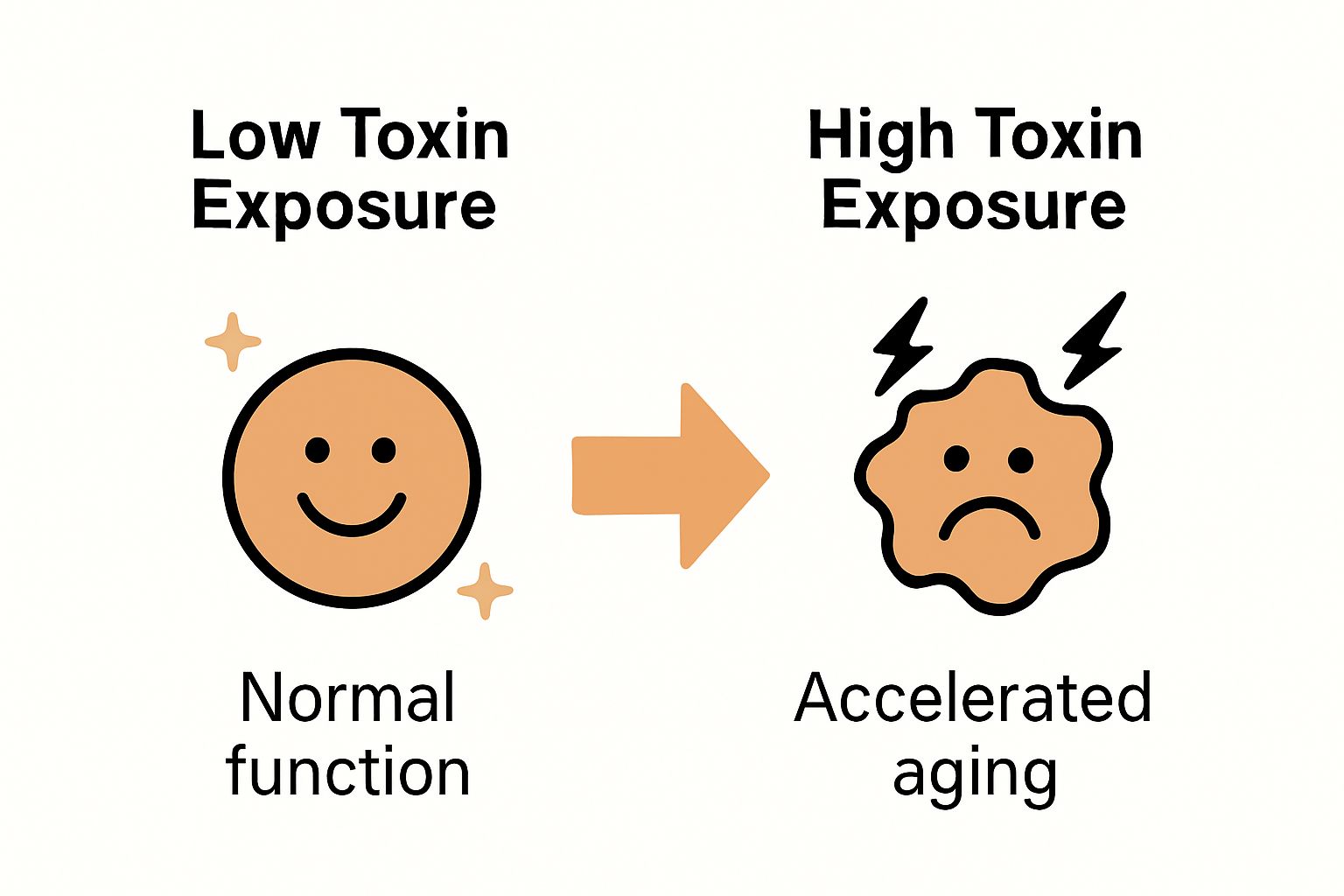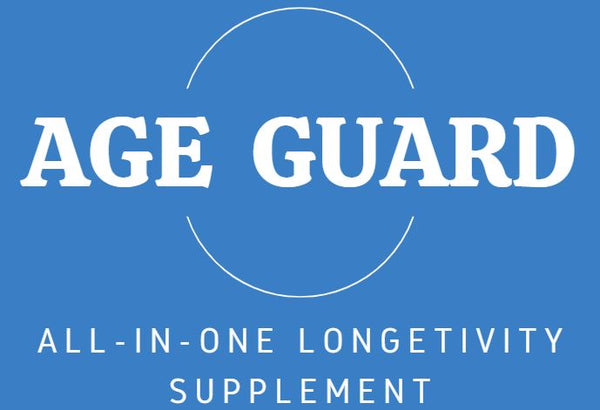
Understanding the Role of Toxins in Aging
Share
Toxins are everywhere, from the air we breathe to the foods on our plates, and they have a deeper impact on aging than most people realize. Most assume aging is just about growing older with time, but scientists have discovered a direct link: chronic toxin exposure can increase your risk of age-related disease, while people with lower exposure actually show significantly better long-term health. This flips the script on what really speeds up or slows down the clock on our bodies.
Table of Contents
- What Are Toxins And How Do They Affect Aging?
- The Biological Mechanisms Linking Toxins To Aging
- Why Understanding Toxins Is Vital For Longevity
- The Impact Of Environmental Toxins On Cellular Health
- Strategies For Reducing Toxin Exposure In Daily Life
Quick Summary
| Takeaway | Explanation |
|---|---|
| Toxins accelerate aging through cell damage | Toxins disrupt cellular health, leading to oxidative stress and inflammation, which speed up aging processes. |
| Manage toxins to enhance longevity | Reducing exposure to toxins is crucial for maintaining cellular integrity and improving overall health outcomes. |
| Nutrition can counteract toxin effects | Consuming antioxidant-rich and organic foods helps protect cells and enhances detoxification, mitigating toxic accumulation. |
| Be mindful of product choices | Choosing personal care and cleaning products wisely reduces everyday toxin exposure and supports long-term health. |
| Chronic exposure leads to serious health issues | Long-term contact with environmental toxins can result in increased chronic diseases and compromised metabolic function. |
What Are Toxins and How Do They Affect Aging?
Toxins represent a complex category of biological and chemical substances that can profoundly impact human cellular health and accelerate the aging process. Understanding their role requires a comprehensive exploration of how these microscopic agents interact with our body’s intricate systems. Learn more about cellular stress mechanisms to grasp the deeper implications of toxin exposure.
The Biological Nature of Toxins
At their core, toxins are substances capable of causing cellular damage through multiple mechanisms. These harmful compounds can originate from various sources, including environmental pollutants, industrial chemicals, processed foods, and even byproducts generated within our own metabolic processes. According to research from the National Institutes of Health, chronic exposure to toxins triggers a cascade of biochemical reactions that systematically compromise cellular integrity.
Key characteristics of toxins include:
- Ability to disrupt normal cellular communication
- Potential to generate excessive free radicals
- Capacity to induce inflammatory responses
- Mechanism for damaging genetic material
Toxins and Accelerated Aging Mechanisms
The relationship between toxins and aging is fundamentally rooted in oxidative stress and mitochondrial dysfunction. When toxins penetrate cellular membranes, they initiate a destructive process that progressively undermines the body’s natural regenerative capabilities. This continuous assault leads to accumulated damage, reduced cellular efficiency, and accelerated biological aging.
Cellular defense mechanisms become progressively overwhelmed with sustained toxin exposure, resulting in decreased metabolic performance, compromised immune function, and increased vulnerability to age-related degenerative conditions. The cumulative impact transforms these microscopic interactions into a significant driver of premature cellular aging, making toxin management a critical component of comprehensive wellness strategies.
The Biological Mechanisms Linking Toxins to Aging
Toxins interact with human biology through complex mechanisms that systematically undermine cellular health and accelerate the aging process. Explore our comprehensive approach to cellular protection and understand how these microscopic interactions impact long-term wellness.
Oxidative Stress and Cellular Damage
The primary mechanism through which toxins accelerate aging involves generating reactive oxygen species (ROS) and inducing oxidative stress. According to research from the National Institutes of Health, these harmful molecules create a destructive cascade that progressively compromises cellular function. ROS attack critical cellular components, including:
- Mitochondrial DNA
- Protein structures
- Cellular membrane lipids
- Genetic regulatory mechanisms
This continuous molecular assault leads to cumulative damage that exceeds the body’s natural repair capabilities, resulting in accelerated cellular aging and decreased physiological resilience.
Inflammatory Response and Cellular Aging
Toxins trigger chronic inflammatory responses that further contribute to biological aging. When introduced to cellular environments, these substances activate immune system pathways that release pro inflammatory cytokines. The persistent inflammatory state disrupts normal cellular communication, impairs regenerative processes, and gradually diminishes the body’s capacity to maintain optimal metabolic function.
The intricate interplay between toxin exposure, oxidative stress, and inflammatory responses creates a compounding effect that systematically erodes cellular integrity.
Below is a table summarizing the key biological mechanisms by which toxins accelerate the aging process, highlighting how each one contributes to cellular decline.
| Mechanism | How It Works | Impact on Aging |
|---|---|---|
| Oxidative Stress | Toxins increase reactive oxygen species (ROS) production | Cumulative cell and DNA damage |
| Inflammation | Triggers chronic inflammatory response | Impaired cellular repair and function |
| Mitochondrial Dysfunction | Disrupts energy production and damages mitochondrial DNA | Reduced energy, cellular efficiency loss |
| Epigenetic Modifications | Alters gene expression through changes in cellular signaling | Long-term changes in aging and health |
| Genetic Material Damage | Causes DNA mutations and regulatory disruption | Increased risk of age-related diseases |
Why Understanding Toxins is Vital for Longevity
Comprehending the intricate relationship between toxins and human longevity represents a critical frontier in preventative health strategies. Discover our comprehensive longevity supplement guide to gain deeper insights into protecting cellular health and extending biological vitality.
Long-Term Health Implications
Understanding toxins transcends mere scientific curiosity and directly impacts our ability to mitigate age-related decline. According to research published in epidemiological studies, individuals with lower lifetime exposure to environmental toxins demonstrate significantly improved health outcomes, including:
- Reduced incidence of chronic diseases
- Enhanced cellular repair mechanisms
- More stable genetic expression
- Improved metabolic resilience
These findings underscore the profound connection between toxin management and sustainable wellness, revealing how proactive environmental awareness can substantially influence long-term health trajectories.

Strategic Wellness and Preventative Approaches
Recognizing toxins’ role in aging empowers individuals to develop targeted interventions that mitigate cellular damage. By understanding specific toxin sources and their biological interactions, people can implement strategic lifestyle modifications that interrupt progressive aging mechanisms.
The scientific community increasingly views toxin comprehension as a fundamental pillar of preventative medicine. Strategic awareness allows for more nuanced approaches to health maintenance, transforming passive biological experiences into actively managed wellness journeys. This paradigm shift represents a sophisticated understanding of human aging as a complex, modifiable process rather than an inevitable decline.
The Impact of Environmental Toxins on Cellular Health
Environmental toxins represent a pervasive threat to cellular integrity, silently undermining biological systems through complex molecular interactions. Explore our cellular health boosters guide to understand comprehensive strategies for protecting cellular resilience.
Mitochondrial Dysfunction and Energy Production
The most immediate impact of environmental toxins occurs at the mitochondrial level, where cellular energy production becomes systematically compromised. According to research published in environmental health studies, exposure to toxins like particulate matter and heavy metals disrupts critical metabolic processes, leading to profound cellular consequences:
- Reduced ATP energy generation
- Increased oxidative stress
- Accelerated mitochondrial DNA damage
- Impaired cellular repair mechanisms
These disruptions transform mitochondria from efficient energy generators into sources of progressive cellular deterioration, fundamentally altering the body’s metabolic performance.
Epigenetic Regulation and Gene Expression
Beyond immediate metabolic impacts, environmental toxins fundamentally reshape genetic expression through epigenetic modifications. By interfering with normal cellular signaling mechanisms, these microscopic agents can trigger cascading changes that extend far beyond initial exposure.
The persistent interaction between toxins and cellular systems creates a complex landscape of biological adaptation, where temporary environmental challenges can induce long-term genetic reprogramming. This sophisticated mechanism underscores the profound and often invisible ways environmental factors can reshape cellular health, transforming external interactions into internal molecular transformations.
Strategies for Reducing Toxin Exposure in Daily Life
Navigating the complex landscape of toxin reduction requires a multifaceted approach that integrates conscious lifestyle choices and strategic environmental management. Explore our comprehensive wellness strategies to develop a holistic framework for minimizing toxic interactions.
Dietary and Nutritional Interventions
Nutrition represents a powerful frontline defense against toxic accumulation. According to research published in environmental health journals, strategic dietary choices can significantly mitigate toxin absorption and enhance the body’s natural detoxification processes. Key nutritional strategies include:
- Consuming antioxidant-rich foods like berries and leafy greens
- Incorporating cruciferous vegetables that support liver function
- Choosing organic produce to minimize pesticide exposure
- Prioritizing whole, unprocessed food sources
These dietary interventions create a robust internal environment that actively counteracts toxic molecular interactions, transforming nutrition from mere sustenance to a sophisticated cellular protection mechanism.
Environmental Modification and Personal Care
Reducing toxin exposure extends beyond dietary considerations, encompassing comprehensive lifestyle and environmental modifications. Critical strategies involve minimizing contact with known toxic sources through intentional product selection and environmental awareness.
By understanding the intricate pathways through which toxins enter biological systems, individuals can develop proactive approaches that systematically reduce toxic burden.
This table presents a concise comparison of common strategies for reducing toxin exposure in daily life, showing the main approaches and their specific focus areas.
| Strategy | Primary Focus | Example Actions |
|---|---|---|
| Dietary Interventions | Minimizing intake of toxic substances via food | Eat organic, increase antioxidants |
| Nutritional Choices | Supporting detoxification and liver function | Add cruciferous vegetables, whole foods |
| Environmental Modification | Reducing environmental toxic sources | Choose non-toxic cleaning products, air quality |
| Personal Care Changes | Lowering exposure from personal products | Select non-toxic soaps, shampoos, cosmetics |
| Lifestyle Awareness | Ongoing proactive reduction of exposure | Evaluate environments, read product labels |
 This involves critically evaluating personal care products, household cleaning agents, and environmental interactions to create a protective ecosystem that supports long-term cellular health and resilience.
This involves critically evaluating personal care products, household cleaning agents, and environmental interactions to create a protective ecosystem that supports long-term cellular health and resilience.
Stop Premature Aging at the Cellular Level—Act Against Toxins Today
Reading about the hidden effects of toxins can be overwhelming. You have learned how these harmful substances create oxidative stress, disrupt gene expression, and trigger chronic inflammation. The pain is real: daily toxin exposure quietly accelerates biological aging, weakens energy levels, and makes it harder to maintain youthful skin and vitality. As you think about safeguarding your body, it is clear that managing toxins and supporting cellular defense isn’t optional if you want to age well.

Give your body the protection it needs by exploring Age Guard. This supplement is expertly crafted with NMN, collagen, spermidine, and antioxidants that were chosen to help counteract the cellular damage caused by toxins and oxidative stress. Backed by science and driven by your desire for longevity, Age Guard can become a cornerstone in your fight for better health. Do not let invisible toxins control your future. Visit our website now and take your first step toward stronger cellular health and a more resilient aging process.
Frequently Asked Questions
What are the main sources of toxins affecting aging?
Toxins can originate from various sources, including environmental pollutants, industrial chemicals, processed foods, and metabolic byproducts generated within our own bodies.
How do toxins accelerate the aging process?
Toxins cause oxidative stress and mitochondrial dysfunction, leading to cellular damage and compromised regenerative capabilities, which contributes to accelerated biological aging.
What role do dietary choices play in reducing toxin exposure?
Strategic dietary choices, such as consuming antioxidant-rich foods and prioritizing organic produce, can significantly mitigate toxin absorption and enhance the body’s natural detoxification processes.
How do environmental toxins impact cellular health?
Environmental toxins disrupt cellular energy production and can lead to epigenetic changes that affect gene expression, resulting in long-term repercussions for cellular health and aging.
